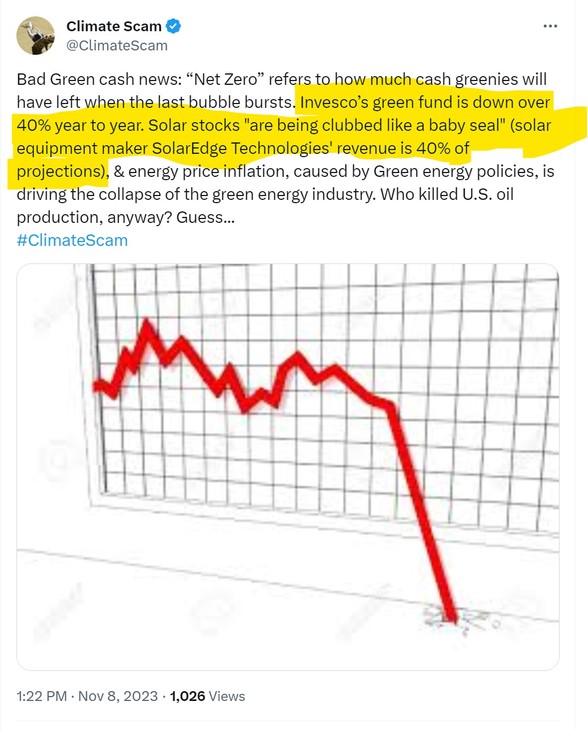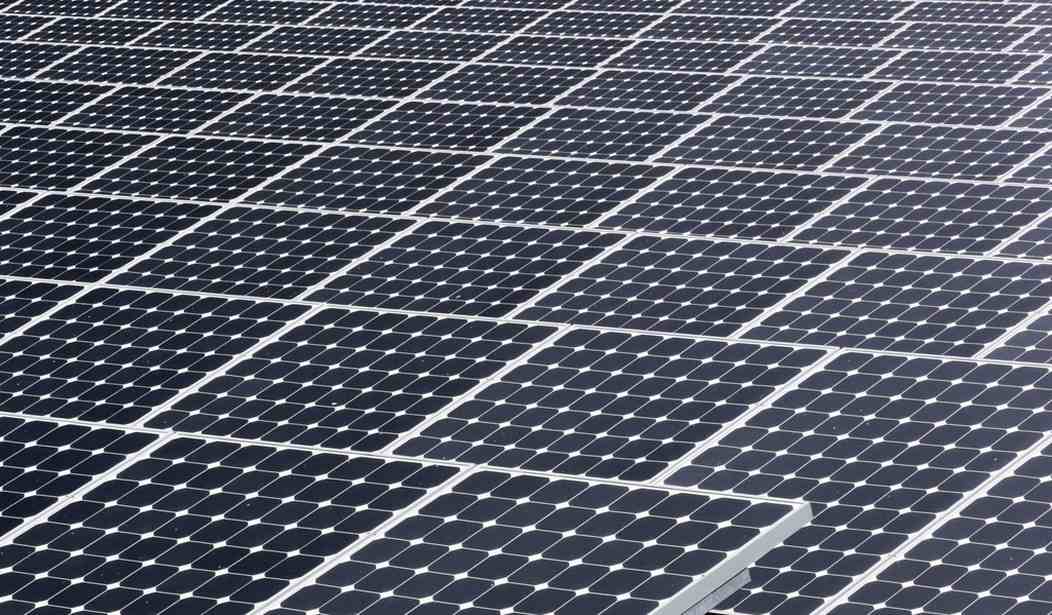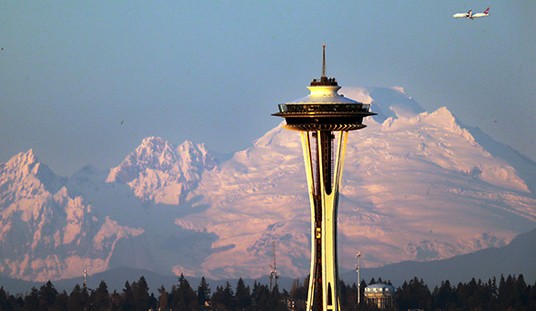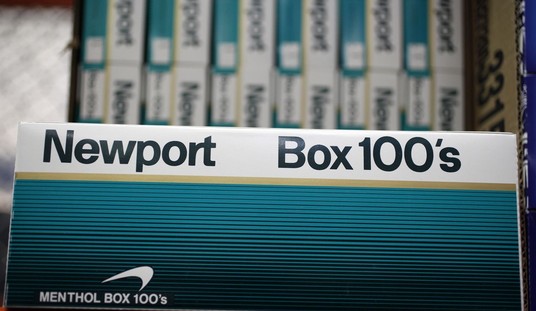While it’s been a disaster in the wind industry lately (and fun as the dickens to cover) (Did I tell you Ørsted’s CFO and COO got the boot?), I hadn’t really had a chance to check in with the solar half of the big Green dream. You know, see if things are shaking out or just shaky?
A quick glance around recent news reports is pointing to an industry wobbling like a bowl of Jello.

Although I do like “clubbed like a baby seal” – that’s pretty descriptive.
And it’s once again all based on the fantasy that the Green energy sector is cheaper and will eventually be self sustaining – “eventually” being the operative word. It has been decades and billions and billions poured into the grift, with goverment mandates to ensure our cooperation, and still the second the environment shifts, the renewables are completely unable to cope, less mind survive.
They are too dependent on perpetual handouts and perfect conditions, having never made any moves to become real live businesses, who can adapt as needed to less-than-perfect conditions..
Shares of Canadian Solar were falling sharply after the company fell short on quarterly earnings and sales.
It’s the latest in a line of solar companies struggling in a high-interest-rate environment.
…The broader solar industry has been having a tough time lately—largely due to high interest rates, which have made it more challenging for consumers to finance solar installations. This year, Canadian Solar stock has dropped 36%, Array Technologies (ARRY) has fallen 23%, First Solar (FSLR) has declined 3.1%, Sunrun (RUN) was off 56%, and Enphase Energy (ENPH) has plummeted 67%.
Good Morning from #Germany, where another green stock gets hammered. SMA Solar falls to a new 2023 low due to an order slowdown which puts risk on 2024 estimates. Despite billions invested in the energy transition, all German green stocks have lost a lot of ground in 2023. pic.twitter.com/Cjx4dnYMw7
— Holger Zschaepitz (@Schuldensuehner) November 9, 2023
Surviving by feeding at the government trough alone.
Things were looking up for the U.S. solar-power industry. The Inflation Reduction Act, the climate legislation that passed in August 2022, boosted the savings of anyone looking to go solar, among its several clean-energy incentives.
A little over a year later, however, investors sentiment about solar, particularly residential solar, is at a trough, the IRA notwithstanding.
“After a painful earnings season, we look to pick up the pieces and move forward,” James West, a analyst with Evercore ISI, said in a note Tuesday.
Just about every major U.S. solar company had big quarterly misses. Invesco Solar ETF TAN is down nearly 40% this year, contrasting with gains of around 14% for the S&P 500 index SPX.
Around the country, folks are waking up, too. Much as opposition to wind has blown up organically, so, too, has citizen pushback to massive solar farms ruining the landscape and destroying valuable farmland for installations. Rural communities are passing “no renewable installations” regulations in order to protect their land from large scale renewable developers before they can get their hooks into landowners. This latest I found was in Kansas.
Companies will not be allowed to build wind and solar farms in Harvey County. The Harvey County Commission voted unanimously Tuesday to ban commercial wind and utility-scale solar renewable energy projects in the county.
The new regulation still allows personal wind and solar energy installations, such as those used at homes, and limited-scale solar construction.
That fact that these Green energy grifts gobble up so much territory for so little return really is the shocker when push comes to shove. There’s nothing uglier.
State governments – even those deep into the climate cult’s clutches – have been backstabbing the industries they themselves have pushed on their own citizens, and slipping the shiv into those very same citizens at the same time. California, one of the most rabidly renewable states in the union – if not the worst – has managed to shiv every solar panel purchaser in the state in the back. It’s now fixin’ to do the same to farmers and, say, like, apartment buildings who also have arrays that are shared.
The California Public Utilities Commission (CPUC) has released a proposed decision that is expected to be harmful to the value of rooftop solar for renters in multifamily housing, farms, and schools.
The decision sets hard limits on how much electricity produced by rooftop solar can be self-consumed by multi-meter properties. The policy effectively forces customers to first sell their solar production to the utility, and then buy it back at higher rates.
…California’s rooftop solar market has already taken heavy blows to demand in recent months as Net Energy Metering (NEM) 3.0 was implemented, a move that dramatically slashed compensation rates for exporting excess solar production to the grid.
Despite warnings from the industry, environmentalists and California residents that the move would be a devastating blow to residential solar, the California Public Utilities Commission (CPUC) moved forward with NEM 3.0, gutting the value of sending excess local solar generation to the grid.
And despite assurances from NEM 3.0 proponents that the industry would weather the storm and readily start attaching batteries to customer systems, demand is now forecast to fall by nearly 40% in California through next year, according to Wood Mackenzie. The problem has been exacerbated by rising interest rates that have worsened the loan packages offered to customers.
There is little point to taking on the excess burden of rooftop solar payments and maintenance if there isn’t some sort of benefit to be received from it besides #FeelGoodz .
Your electricity still goes off, but now you’re paying more, plus a hefty payment on the solar system you bought from whatever company?
That math doesn’t add up, at least for a rational consumer. As a cultist YMMV. I don’t see them selling them at the rate they were able to previously.
All of this is “endangering America’s environmental goals.” (And I know it’s paywalled – I just loved the headline)
Clean-Energy Stocks Have Collapsed. What Comes Next.
Stocks related to wind, solar and other forms of renewable energy have fallen by a third this year. Only a handful may be ready to rebound.Clean-energy stocks are suffering through their worst slump in years, causing the industry’s value to tumble by tens of billions of dollars and endangering America’s environmental goals.
Major auto manufacturers like General Motors (ticker: GM) and Ford Motor (F) have delayed plans to roll out electric vehicles. Offshore wind developers are canceling or delaying projects that were expected to provide millions of Americans with carbon-free electricity. Homeowners, even in climate-conscious states like California, are buying fewer solar panels for their roofs. And green-power producers known for offering steady, reliable dividends have lost their veneer of safety. Rising interest rates have posed the gravest challenge to the industry, but supply-chain problems, inadequate electric transmission infrastructure, and competition from China are hurting, too.
Good. Because you know what else was endangered?
Us and our way of life.
And I’m 100% #TeamUS








Join the conversation as a VIP Member